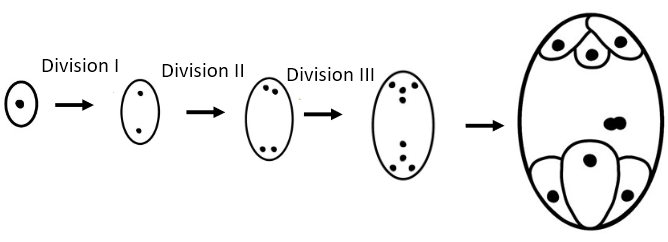
Most common type of embryo sac reported in angiosperm is of
(a) Polygonum
(b) Oenothera
(c) Adoxa
(d) Plumbago
Answer
504.9k+ views
Hint: The most common type of embryo sac is an 8 nucleated embryo sac and develops from the chalazal megaspore. Three nuclear divisions occur in order to form this type of embryo sac.
Complete Answer:
The embryo sac that occurs in the majority of flowering plants is monosporic eight‐nucleate and seven‐celled embryo sac and is of polygonum type. This type of embryo sac is found in about 81% of the plant families. It was described for the first time by Strasburger in Polygonum divaricatum and considered to be formed by three nuclear divisions that result in 8 nuclei. It is formed from the chalazal megaspore of the megaspore tetrad and comprises 3-celled egg apparatus, three antipodals, and a central cell that is binucleate.
The monosporic embryo sac develops from a single megaspore and in these embryo sacs all the nuclei, that are present, are found to be genetically similar to each other. This is because all the nuclei have been derived by mitosis in a single nucleus. After the first mitotic division, the two daughter nuclei move apart and reach to the opposite poles. Most part of the cytoplasm gets aggregated around the two nuclei and the rest part of the cytoplasm forms a thin peripheral layer while the central portion is occupied by a large vacuole. On the next division, a 4-celled stage is reached and in the subsequent ones, the 8-celled stage is acquired.

So, the correct answer is,’Polygonum’.
Note: Oenothera is a monosporic 4-nucleated embryo sac and develops from the micropylar megaspore. It lacks antipodals.
- Adoxa and Plumbago are the types of tetrasporic embryo sacs and the nuclei in these embryo sacs are more heterogeneous in comparison to the other types.
Complete Answer:
The embryo sac that occurs in the majority of flowering plants is monosporic eight‐nucleate and seven‐celled embryo sac and is of polygonum type. This type of embryo sac is found in about 81% of the plant families. It was described for the first time by Strasburger in Polygonum divaricatum and considered to be formed by three nuclear divisions that result in 8 nuclei. It is formed from the chalazal megaspore of the megaspore tetrad and comprises 3-celled egg apparatus, three antipodals, and a central cell that is binucleate.
The monosporic embryo sac develops from a single megaspore and in these embryo sacs all the nuclei, that are present, are found to be genetically similar to each other. This is because all the nuclei have been derived by mitosis in a single nucleus. After the first mitotic division, the two daughter nuclei move apart and reach to the opposite poles. Most part of the cytoplasm gets aggregated around the two nuclei and the rest part of the cytoplasm forms a thin peripheral layer while the central portion is occupied by a large vacuole. On the next division, a 4-celled stage is reached and in the subsequent ones, the 8-celled stage is acquired.

So, the correct answer is,’Polygonum’.
Note: Oenothera is a monosporic 4-nucleated embryo sac and develops from the micropylar megaspore. It lacks antipodals.
- Adoxa and Plumbago are the types of tetrasporic embryo sacs and the nuclei in these embryo sacs are more heterogeneous in comparison to the other types.
Recently Updated Pages
Master Class 4 Maths: Engaging Questions & Answers for Success

Master Class 4 English: Engaging Questions & Answers for Success

Master Class 4 Science: Engaging Questions & Answers for Success

Class 4 Question and Answer - Your Ultimate Solutions Guide

Master Class 11 Economics: Engaging Questions & Answers for Success

Master Class 11 Business Studies: Engaging Questions & Answers for Success

Trending doubts
Give 10 examples of unisexual and bisexual flowers

Draw a labelled sketch of the human eye class 12 physics CBSE

Differentiate between homogeneous and heterogeneous class 12 chemistry CBSE

a Tabulate the differences in the characteristics of class 12 chemistry CBSE

Why is the cell called the structural and functional class 12 biology CBSE

Differentiate between insitu conservation and exsitu class 12 biology CBSE




